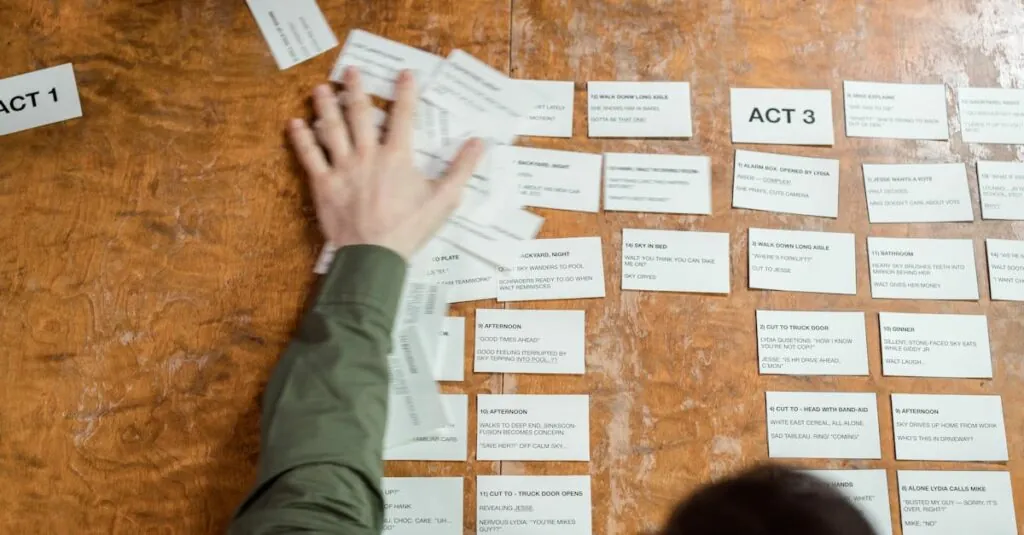Table of Contents
ToggleEver watched a movie and thought, “Wait, what just happened?” You’re not alone. Movie plots can twist and turn like a rollercoaster, leaving viewers dizzy and confused. That’s where plot breakdowns come in, serving as your trusty GPS through the wild world of cinema. They decode the tangled narratives and help you appreciate the genius (or sometimes the absurdity) behind the storytelling.
From mind-bending thrillers to heartwarming rom-coms, understanding the plot can transform your viewing experience from “huh?” to “aha!” Whether you’re a casual viewer or a film buff, these breakdowns shine a spotlight on the key elements that make a movie tick. So grab your popcorn and prepare to dive deep into the intriguing plots that keep audiences on the edge of their seats.
The Importance of Movie Plot Breakdowns
Movie plot breakdowns serve as essential tools for viewers, providing clarity in complex narratives. They transform intricate storylines into accessible summaries.
Understanding Narrative Structure
Understanding narrative structure is crucial for recognizing how stories unfold. Various components, like exposition, rising action, climax, and resolution, shape how viewers perceive a film’s plot. Each segment contributes to overall coherence, guiding audiences through character development and thematic elements. Familiarity with these components allows viewers to appreciate how filmmakers construct tension and emotion, leading to a more rewarding viewing experience.
Enhancing Viewer Engagement
Viewer engagement increases significantly with detailed plot breakdowns. They highlight key events, character motivations, and thematic messages, empowering viewers to follow the story more closely. Access to these insights encourages deeper discussions and analyses, fostering community among film enthusiasts. Active engagement arises from understanding plot nuances, making the viewing experience more immersive. Fans of cinema find that plot breakdowns not only clarify but also enrich their appreciation of filmmaking artistry.
Common Elements in Movie Plot Breakdowns
Understanding key elements in movie plot breakdowns enhances clarity and engagement. Two fundamental aspects stand out: character development and plot twists.
Character Development
Character development shapes viewers’ connection to the narrative. Characters often experience significant growth or transformation throughout the plot. Motivations drive their actions, revealing inner conflicts and goals. Strong character arcs invite audiences to relate to personal struggles. For example, a hero overcoming self-doubt illustrates resilience. Conversely, antagonists may display depth, showcasing relatable flaws. Engaging character traits elevate the plot, inviting debates among viewers. Observing these changes helps audiences appreciate the storyline and themes deeply.
Plot Twists and Turns
Plot twists and turns maintain suspense and intrigue, engaging viewers throughout the film. Unexpected changes in direction challenge audience expectations and provoke thought. A well-crafted twist can redefine understanding, changing the perception of events and characters. Effective use of foreshadowing often hints at these surprises without revealing too much. Films like “The Sixth Sense” exemplify this technique well, as they cleverly conceal secrets until critical moments. Such surprises encourage discussion among audiences, as they dissect implications and meanings behind the twists. This keeps viewers invested, eager to uncover mysteries hidden in the narrative.
Different Approaches to Movie Plot Breakdowns
Movie plot breakdowns can be approached through various techniques. One popular method includes scene-by-scene analysis.
Scene-by-Scene Analysis
Scene-by-scene analysis meticulously breaks down each section of a film. This technique highlights pivotal moments, character interactions, and visual storytelling elements. By examining individual scenes, viewers can grasp narrative pacing and emotional resonance. Each segment contributes to the overall arc, allowing audiences to appreciate subtle details like dialogue and cinematography. Breaking the film into scenes also clarifies the progression of themes and character development, ensuring enhanced understanding. This structured approach proves valuable for both casual audiences and dedicated film scholars.
Thematic Breakdowns
Thematic breakdowns focus on the underlying messages within a film. Each theme often reflects broader societal issues or personal struggles, enriching viewer engagement. Analyzing themes exposes recurring motifs, character conflicts, and narrative style. This approach not only deepens comprehension but also invites introspection about the film’s commentary. Themes like love, betrayal, or redemption often appear through various characters and events, guiding viewers toward connections between plot and overarching messages. As a result, thematic breakdowns foster discussion among audiences, inviting diverse perspectives on a film’s narratives.
Popular Examples of Effective Movie Plot Breakdowns
Movie plot breakdowns can provide valuable insights, showcasing both classic films and contemporary releases. They demonstrate how narratives evolve over time while maintaining essential storytelling elements.
Classic Films
Classic films like “Casablanca” and “Gone with the Wind” serve as exemplary case studies for plot breakdowns. Each narrative unfolds through a combination of romance and conflict, reflecting historical contexts. The character arcs in “Casablanca” highlight moral dilemmas faced during wartime. Meanwhile, “Gone with the Wind” depicts resilience amid personal and societal challenges. These analyses reveal how themes of love and sacrifice permeate the stories, engaging audiences through emotional depth. Detailed breakdowns of such films often illustrate significant character development, enhancing viewer connections to the emotional stakes involved.
Contemporary Releases
Contemporary releases such as “Inception” and “Parasite” utilize complex narratives that benefit from thorough plot breakdowns. Each film employs intricate structures, layering themes like reality versus illusion and class struggle. “Inception” challenges audiences with its non-linear timeline, prompting exploration of subconscious motivations. “Parasite,” on the other hand, uses a genre-blending approach to expose societal disparities effectively. Breakdowns of these films highlight key plot points and character motivations, opening discussions around nuanced themes. Engaging with recent films provides insights into modern storytelling techniques, enriching viewer experiences and fostering deeper dialogue about evolving cinematic practices.
Movie plot breakdowns serve as essential tools for navigating the intricate layers of storytelling. They transform complex narratives into accessible insights that enhance viewer engagement. By dissecting elements like character development and plot twists, audiences can forge deeper connections with the films they watch.
These breakdowns not only clarify the narrative structure but also spark conversations that enrich the cinematic experience. Whether exploring timeless classics or modern masterpieces, understanding the nuances of a film’s plot fosters appreciation for the art of storytelling. Engaging with these analyses invites viewers to see beyond the surface, encouraging a more profound exploration of themes and character arcs. Ultimately, embracing movie plot breakdowns elevates the overall enjoyment of cinema, making each viewing a richer experience.




